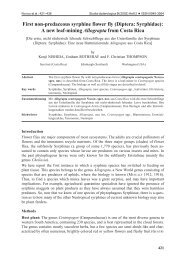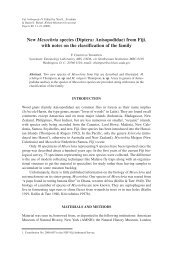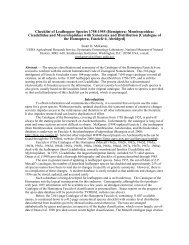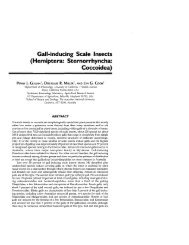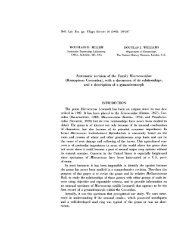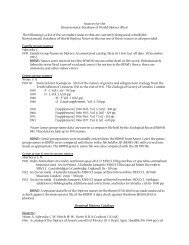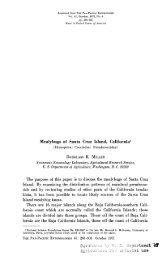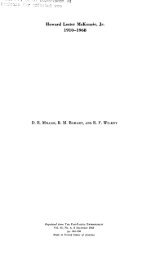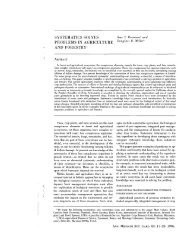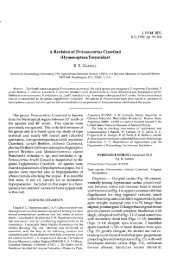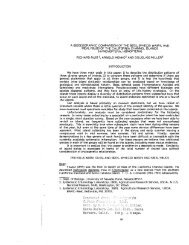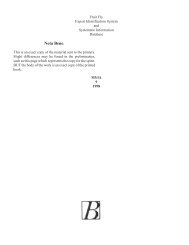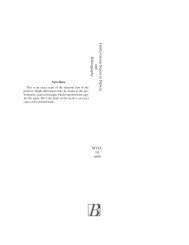A NEW SPECIES OF PUTa AND A PRELIMINARY ANALYSIS OF ...
A NEW SPECIES OF PUTa AND A PRELIMINARY ANALYSIS OF ...
A NEW SPECIES OF PUTa AND A PRELIMINARY ANALYSIS OF ...
You also want an ePaper? Increase the reach of your titles
YUMPU automatically turns print PDFs into web optimized ePapers that Google loves.
2 MIllER & MILLER: puro KOSZTARABI<br />
three pairs of eyes and distinct tail-fonning pore clusters, and two of the<br />
three have abdominal spiracles.<br />
The objectives of this paper are: 1) to describe the first species of Pulo<br />
known from the eastern United States and place it in a key to species; 2)<br />
to present a preliminary key to the adult males of available Pulo species;<br />
3) to provide a world checklist of Pulo species; and 4) to report on the<br />
relationships of Pulo with selected margarodid, pseudococcid, and<br />
phenacoleachid genera.<br />
MATERIALS <strong>AND</strong> METHODS<br />
Morphological tenninology follows McKenzie (1967) for the adult<br />
female, Afifi (1968) for the adult male, and Miller (1991) for first and<br />
second instars. Measurements and numbers are from 10 specimens,<br />
when available, and are given as a mean with ranges in parentheses.<br />
Specimens of the genus Pulo exhibit an array of sclerotized areas that<br />
contain concentrations of conical setae and trilocular pores. In most<br />
mealybugs, these areas would be called cerarii, but most authors have<br />
treated only those areas that are located near the body margin as true<br />
cerarii, and have tenned similar areas within the confines of the body<br />
perimeter as setal areas with basal sclerotization. We will continue this<br />
usage, but also note that many specimens of Pulo koszlarabi have<br />
cerarian-like structures scattered over most of the dorsum. Some<br />
specimens of P. koszlarabi were reared in the greenhouse on Spartina<br />
alterniRora Loisel. because this grass was readily available and its natural<br />
host of Danlhonia spicala (L) Beauvois ex R. & S. was not easily<br />
accessible. Spartina alterniRora should not be considered a natural host<br />
of this species.<br />
Cladistic analyses were perfonned using Hennig86 (Farris, 1988). The<br />
data matrix consisted of 23 taxa and 38 characters. Outgroup comparison<br />
was used to detennine polarities of characters. The Margarodidae were<br />
considered the most primitive Coccoidea by Beardsley (1968), and<br />
Matsucoccus biselosus Morrison was chosen as a rootoutgroup species.<br />
The implicit enumeration (ie) command was applied to detennine the<br />
most parsimonious trees. A strict consensus tree was generated by using<br />
the "Nelson" command.<br />
Characters were selected from adult males, adult females, and first<br />
instars. Thirty-eight characters were used in the analysis. Characters 4,<br />
9, 13, and 21 (treated as non-additive) and 1, 11, 12, 14, 19, 27, 28, 29,



